VVAM Newsletter 89 – 2003
FRIENDS OF THE AIRBORNE MUSEUM
Newsletter No. 89, February 2003
Translated by Cathrien and Peter Clark Representative in Great Britain: Niall Cherry, 3 Church Road, Warton, Lancs, PR4 1BD Tel. home 0177-2632764
From the editors
As announced in the previous Newsletter this is a double number, thus enabling us to include most of the copy that was omitted from the last issue due to lack of space.
Miniature Hartenstein.
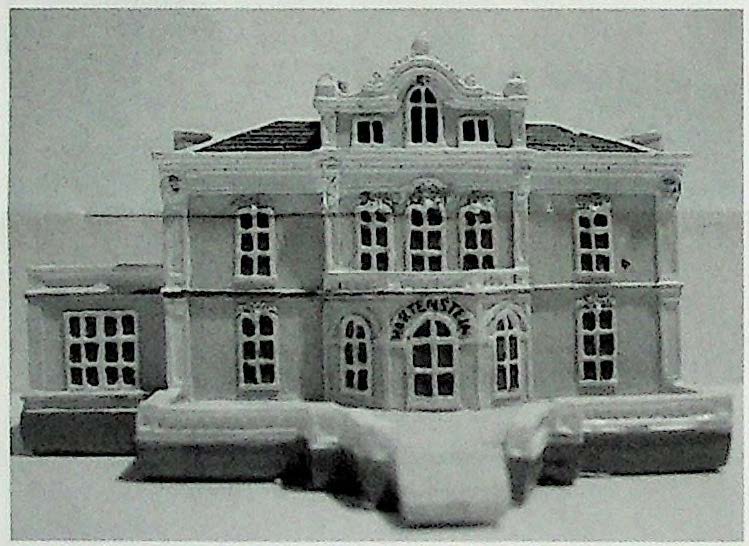 (photo Berry de Reus)
(photo Berry de Reus)
Hartenstein in Miniature
Miniature models of the Hartenstein building have recently become available. In order to ensure accuracy of detail etc, use was made of the original building drawings and photos. The model measures 8 x 7 x 4 cm and is made from a synthetic material that feels like stone but is unbreakable. ‘Miniature Hartenstein’ is for sale at the museum shop and costs € 8,50.
Diary of events, 2003
Below is a provisional list of events for 2003 that are to be organised by our society (SFAM), and in which the SFAM will be taking part (list subject to change): Friday 7 March: ‘Drop-in evening’ at the Airborne Museum;
Saturday 29 March: SFAM AGM & Theme Afternoon;
Saturday 10 May: Betuwe excursion repeat;
Saturday 24 May: Book fair;
28 May – 1 June inc.: Excursion to Normandy;
20, 21 and 22 June: Weekend in Oosterbeek for British members. A Social Evening will be held in the Airborne Museum on Friday evening 20 June, to which Dutch members of the SFAM are cordially invited;
October/November (exact date to be finalised): Excursion to the 6th British Airborne Division’s battle zone at Hamminkeln in Germany;
22 November: Lecture on the role of the Royal Corps of Signals during the Battle of Arnhem.
Annual Meeting and Theme Afternoon on 29 March
You are invited to attend the 23rd AGM / Annual Meeting of the Society of Friends of the Airborne Museum on Saturday 29 March 2003. The meeting will be held in the Concert Hall, Rozensteeg 3 in Oosterbeek, starting at 10.30 hours.
The agenda is as follows:
1. Opening
2. Minutes of the AGM of 6 April 2002
3. General Report, 2002
4. Financial Report 2002
5. Budget for 2003
6. Audit Committee Report
7. Management Board election
8. Appointment of reserve member to the Audit Committee
9. Questions
10. Closure of meeting.
Points 3 and 4: You will be given the General and Financial Reports on arrival, and the Audit Committee Report will be available for perusal at the hall entrance half an hour before the opening of the meeting. You can also request copies of the General and Financial Reports by writing to the Treasurer, Mr F. Miedema, Woudstralaan 24, 6862 XE,
Oosterbeek, enclosing a stamped (90 Eurocent stamp), self-addressed envelope.
Point 7: Mr C.C. van den Bosch will be stepping down and does not intend standing for re-election. The board has proposed Mr E. van der Meiden from Oosterbeek as new board member.
Article 8 of the Statutes allows members to propose alternative candidates. Notification of such proposals needs to be made to the secretary (Nachtegaallaan 28, 6713 BZ, Ede), in writing, at the latest ten days before the meeting. Each proposal must be signed by at least ten members and accompanied by a declaration of intent from the candidate, who must be a society member and an adult.
After the AGM the afternoon programme will start with lunch in the Concert Hall, followed by a walking tour of the area around the Old Church, where the 1st Light Regiment, Royal Artillery were positioned in September 1944. This unit comprised three Batteries, each with two Troops, each troop possessing four 75mm Pack Howitzers.
During the afternoon of the excursion it is hoped that one of the original high-trajectory guns will be set up in an actual September 1944 position.
The lunch and participation in the excursion will cost € 25,-, which should be received by the Treasurer before 20 March. As well as covering the lunch and an excursion guide, part of this charge will go towards the costs involved in bringing this original howitzer to Oosterbeek. The maximum number of members participating in the Theme Afternoon is limited to fifty.
A good preparation for the theme afternoon would be to read the book ‘The Gunners at Arnhem’ by Peter Wilkinson. The book is on sale at the Airborne Museum ‘Hartenstein’.
Excursion to the battle zone in the Betuwe
As a follow-up to the excursions to the areas of operation of the 82nd and 101st US Airborne Divisions in the south of the Netherlands, the Friends’ Society organised a bus trip to the former battlefields at Nijmegen and in the Betuwe, which took place on 2 November 2002. Eugene Wijnhoud, Geert Maassen and Marcel Anker were the guides. The first visit was to the Jonkerbosch Cemetery near Nijmegen, and it was remarkable how few of the participants had visited this cemetery before, despite the fact that a number of men from the 1st British Airborne Division are buried there. Then, following a trip through Nijmegen, the area around the power station on the south bank of the river Waal was visited. The positions of the artillery that provided support to the troops at Oosterbeek are still recognisable in spite of the new ‘urbanisation’.
A visit to the NUON building, and especially the view from the roof of the spot where the 3rd Battalion of the 504th Regiment, 82nd US Airborne Division crossed the Waal on 20 September 1944, remains spectacular. The area around the southern approach to the Waal bridge was the next subject. Here, too, all traces of the fighting have disappeared under the post war re-development. A good guide is a ‘must’ if one wishes to get an idea of how things were at the time of the events in 1944. For example, how many people know that a German gun can still be seen near the southern approach to the bridge? After lunch the excursion continued with an overview of the battle around Driel. Although this area was rebuilt following the destruction sustained during the war, and many new houses have been built since, it was nevertheless possible to find many historic sites thanks to the excellent guidance of Geert Maassen. The afternoon was rounded off with a visit to the Polish monument in Driel.
Those who missed this day out will have another chance on Saturday 10 May, when the excursion will be repeated in co-operation with the Documentation Group ’40-’45. The excursion costs € 30,- and bookings must be in by 7 April.
The book ‘Operation Market Garden, Then and Now’ by Karel Margry is recommended as preparation for this excursion.
(W. Boersma)
Geert Maassen (second from the left) provides explanation during the excursion to the Betuwe on 2 November last year.
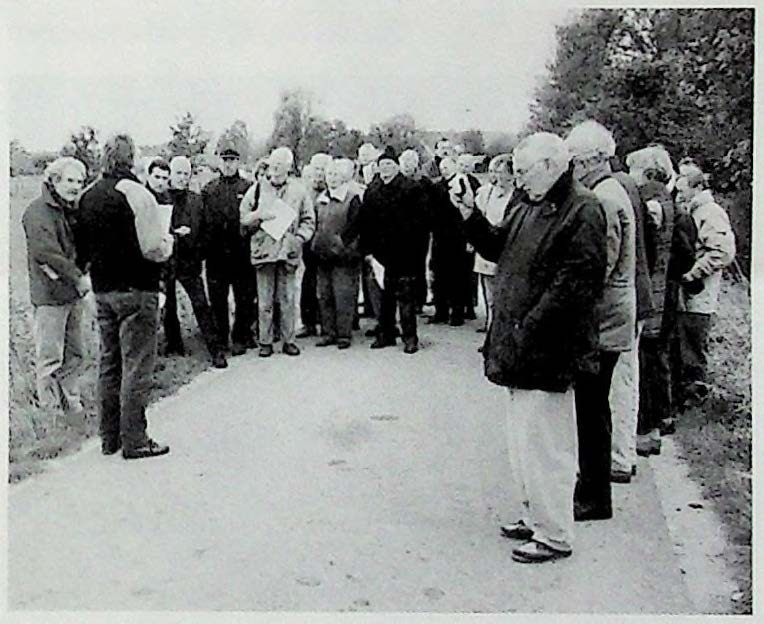 (photo W. Boersma)
(photo W. Boersma)
‘Drop-in evening’
On Friday evening 7 March next, another ‘Drop-in evening’ for Society Friends is to be held in the Airborne Museum. For the occasion the ‘Hartenstein’ will be open from 19.00 hours. The archives, library and depot will be open to visitors, providing an ideal opportunity for taking a look behind the scenes! The evening is also intended to allow people to come together and exchange ideas over a cup of coffee. Members wishing to bring along documents or material from their personal collection for perusal, are requested to get in touch with W. Boersma beforehand so that sufficient tables or display cabinets can be arranged. We expect a lot of people! (Wybo Boersma)
Exhibition 2003
This year the Airborne Museum’s themed exhibition will feature the deployment of the Royal Artillery at the Battle of Arnhem. The title of the exhibition is ‘Fire Support for the Airborne’. Attention will focus on the role of the 75 mm Pack Howitzers, the 6-pounder and 17-pounder guns, the 2 cm Polsten Gun, and possibly on the fire support provided from Nijmegen, and later from the Betuwe, from 21 September onwards. Members of the Society who have documents or material on this subject and who would like to help with this exhibition are kindly asked to contact W. Boersma by telephone at the museum (026 3337710), private (0318 639633), or e-mail: w.boersma@wxs.nl.
The exhibition will open on 25 April next and continue through to 2 November 2003.
Battlefields Trust Conference
‘The Battlefields Trust’ came into being in England in 1991. Its objective is to publicise and protect historic battlefields both in Britain and on the European mainland. The Trust’s first years of existence were spent listing the existing battlefields in Britain itself. Then it began the work of convincing the local authorities of the importance of these sites in their area, not simply from the historical aspect but also as part of tourist policy. It keeps a close eye on building development plans and looks critically at the construction of new roads. Awareness of the battlefields is promoted by the holding of battlefield tours, lectures, signposting, the supporting of information centres, etc.
Meanwhile the Trust has grown into a society with several hundred members and, thanks to a national lottery grant, has recently taken on a full time employee. The Airborne Museum ‘Hartenstein’ has been a member of the Battlefields Trust since its inauguration.
Every year this body organises a conference, the venues alternating between Britain and the Continent. Last year the meeting was held in the Papendal National Sports Centre in the Netherlands from 24 to 27 October. The subject was ‘Battlefields on the Rhine, Battlefields and Tourism’. A number of lectures were given, the lecturers including Lieutenant Colonel Kinkert of the KMA (Royal Dutch Military Academy) on ‘Battlefield tours as part of military training’, Lieutenant Colonel Brongers (Ret’d) about ‘The Battle for the Grebbeberg’, and Captain Peter Starling from the Royal Army Medical Corps Museum about ‘Schoonoord, a hospital in the Battle’. In addition, detailed visits were made to the Grebbeberg, the battlefield around Arnhem, and the Airborne Museum. The participants laid a wreath at the Airborne Cemetery.
On Friday afternoon the company was the guest of Renkum municipal council. In his welcoming address, the acting burgomaster of Renkum Mr Joop Verheij said how the council supplements the spearhead of its tourist policy, and the significance of the Airborne Museum to the municipality. The conference ended on Saturday evening with dinner in one of Arnhem’s restored medieval cellars. Many sponsors helped in making the conference possible, while the Airborne Museum took care of the organisation. Various members of the Friends Society assisted in the battlefield tours.
The conference was a success, and gave an extra impulse to the promotion of battlefield tourism in the Netherlands, as well as to the Airborne Museum.
(W. Boersma)
Increase in the number of visitors
Last year, 2002, the Airborne Museum ‘Hartenstein’ received more than 60,000 visitors, an increase of approximately 7,000 over the previous year’s total.
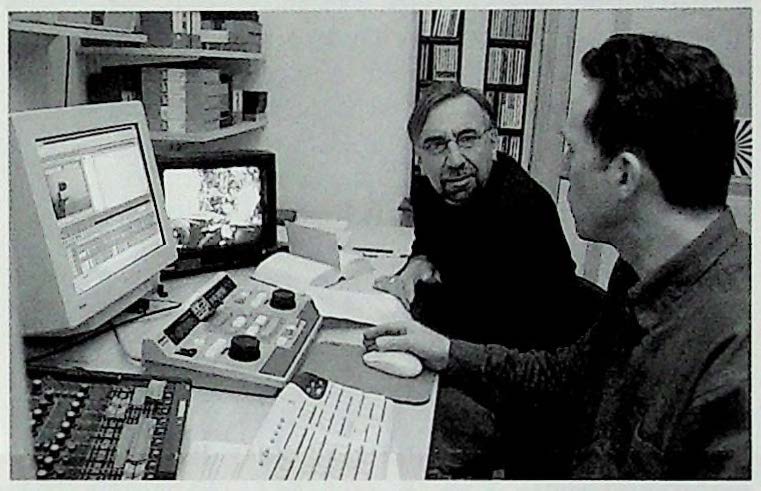 Arend Langenberg and Joop Bal discuss the text for the Airborne Museum’s new audio-visual presentation, (photo Berry de Reus)
Arend Langenberg and Joop Bal discuss the text for the Airborne Museum’s new audio-visual presentation, (photo Berry de Reus)
New audio-visual presentation
The audio-visual presentation linked to the scale model in the Airborne Museum’s large room has recently undergone total renewal. Tire old slide projectors were completely worn out so everything is now on DVD. The entire programme, consisting of photos, film fragments and sound, lasts 17 minutes and is projected onto the large screen above the model with the aid of a ‘beamer’.
Berry de Reus, Joop Bal from Bal Bedrijfsvideo in Oosterbeek and Gerrit Bulten from Burst Video in Veenendaal made up the team that carried out this project. The narrator is Arend Langenberg.
It is also the intention to renew the museum’s other three, small video-presentations.
Gift of Sgt. Robinson’s beret badge
Some time ago the Airborne Museum came into possession of Sgt. Robinson’s beret badge. Sgt. Robinson served with the Grenadier Guardsand was commander of the first tank to cross the Waal bridge in Nijmegen on Wednesday 21 September 1944. For this he was awarded the Distinguished Conduct Medal.
Battlefield Guide ‘ARNHEM, The Landing Grounds and Oosterbeek’
The latest edition in the series ‘Battleground Europe’ by author Frank Steer recently appeared on the scene. It is referred to as ‘a small guide to one part of operation Market Garden’. It deals with both ends of the Oosterbeek ‘centre’ of the Battle of Arnhem, and this by means of a walk and three car trips. The writer wishes to (perhaps has to) share his consuming interest in the Arnhem story. He makes it almost impossible for the readers to stay at home. Travel advice simplifies the decision to make the journey to Oosterbeek, and once there all sorts of small indications ensure the visit is smooth and enjoyable. During the car journeys the author is there at his ‘listener’s’ side, accurately pointing out the way and the places to park. For the ease of the visitor the maps used are of the current situation on which the ’then’ situation is added. The route directions are (also) typographically separate from the actual story, although they do ‘intertwine’ here and there.
It is a compelling story, which occasionally places some of the many players in the battle scene in the spotlight. The choice is a personal one, as is the entire story of what took place, using a personal selection of events. In this, and in the choice of those portrayed, one can perhaps recognise something of the writer’s own logistical background.
The accurate responsibilities of the military units mentioned may not mean much to the first-time visitor, but it brings the story alive. The explanation of military terms, and particularly abbreviations, do fall a little short. Against this, a careful effort has been made to eradicate typing errors, with almost complete success. It is not a book that the ‘battle hardened’ students of ‘Arnhem’ have been anxiously waiting for, but who knows, they too may find one thing or another to criticise in the content of the book. The guide does not have such high aspirations; it is intended as a first step towards generating further interest. That first step can now be made with the warm assistance of a dedicated storyteller. It is hoped that it will find its place in abundance between the other books intended for the same public. The book is for sale at the Airborne Museum shop for € 16,50.
(J.W. van Slooten)
German money from England?!
In September 1944 the Castendijk family lived on the Ommershof estate at the north-west corner of Oosterbeek. Nowadays, the area lying roughly between the present day Ommershoflaan and Graaf van Rechterenweg is largely used by the Felixoord Vegetarian Care Home (the only one in the Netherlands).
In October or November 1944,15 year-old Bob Castendijk found many personal possessions of British soldiers who were cared for on math-esses the Ommershof House cellar. Among the find were photos, letters and money, including 1 Mark and 5 Mark banknotes. Indeed: German money, but printed in the United Kingdom!
As the picture of the front of one of the banknotes shows, the money had been issued by the Alliierte Militarbehorde’, the allied occupation force. Therefore, it was likely that the money was intended for later use by the airborne troops in a, by then, defeated Germany.
It is worth noting however that the men of the 1st British Airborne Division already possessed these notes in September 1944. They had not been ordered to push through to the land of our eastern neighbours, had they?
So the story surrounding the occupation money is not yet told. Much is unclear. Who can lighten our darkness? The editorship waits with bated breath: Jan van Riebeeckweg 39, 6861 BD Oosterbeek. (Geert Maassen)
Allied occupation money found in Ommershof House, Oosterbeek in October/November 1944.
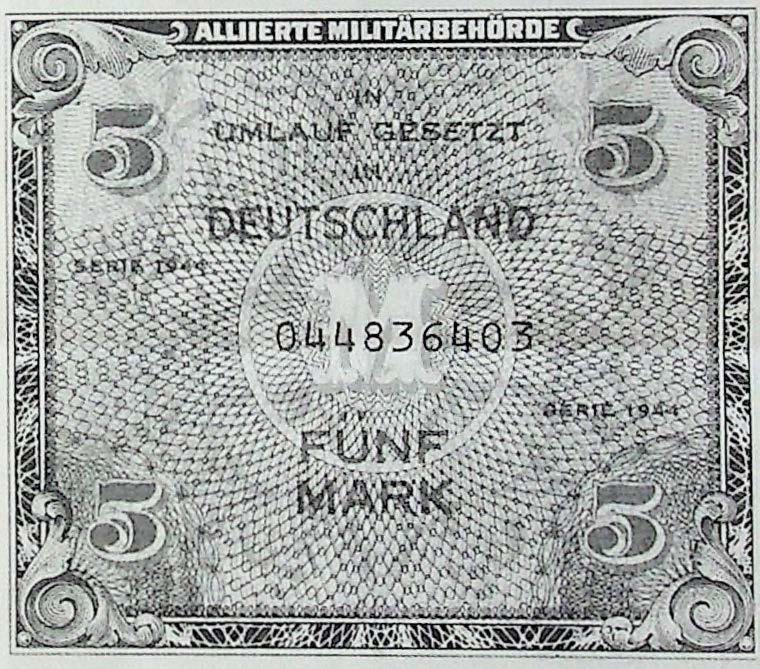 (Castendijk collection, Gelders Archief – Arnhem)
(Castendijk collection, Gelders Archief – Arnhem)
‘Arnhem 1944’ by William F. Buckingham
The seventh part – ‘Arnhem 1944, a reappraisal’, written by William F. Buckingham – in the ‘Battles & Campaigns’ series was published recently. As the title suggests, the author wishes to present a re- evaluation of the Battle of Arnhem. He analyses the training of the British parachute units and the 1st Airborne Division in particular, and the command implementation by various commanders at every level, both before and during the battle After an overview of the transition from random parachute units to the fully-fledged ‘Weapon’, and the deployments in North Africa, Italy and Sicily, the leadership and training of the division in 1944 is discussed. Here the writer includes the 1st Polish ndependent Parachute Brigade Group. The Market
plan is then looked at, followed by the fighting in Arnhem and Oosterbeek. In this part the author sometimes refers to events in the American sectors and to the advance of 30 Corps.
The book produces no new viewpoints, and we have read all the criticisms of events before. Nevertheless, everything is brought together again here, with a number of remarkable pronouncements from the British author. The analysis is clear with no ‘benefit of hindsight mud-slinging’.
The printed photos are of moderate quality, and the layout used produces long pages of text which are not very inviting to read. A shame, because the book is well worth reading. The English text is kept simple, making it easy to follow by non-English readers.
Anyone making a serious study of the Battle of Arnhem cannot afford to miss this book.
‘Arnhem 1944, a reappraisal’ by William F. Buckingham, published by Tempus Publishing Ltd. in 2002, ISBN 0 7524 1999 4, 223 pages, illustrated. Price € 23,99. The book is on sale in the ‘Hartenstein’ museum shop.
(W. Boersma)
Normandy excursion 2003
The Airborne Museum will be organising a Battlefield Tour to Normandy to run from 28 May to 1 June 2003 inclusive. During this five-day bus excursion visits will be made to many locations that played an important part on D-day (6 June 1944) and in the weeks that followed. The cost is € 445.
Information and booking via the Airborne Museum.
2002 Annual Report on the Internet
The Annual Report of the Airborne Museum was published in January 2003. The Dutch version can be found on the museum’s website, www.airbornemuseum.com. under the heading: ‘Jaarverslag’.
Roll of Honour
During his search, started many years ago, for information on 1st Battalion, The Parachute Regiment, our member Peter Vrolijk from Rotterdam came across the name of an officer whose participation in the Battle of Arnhem (whether he had fought there) was not entirely clear.
It concerned Lieutenant John T.M. MacFadden, who served originally with the Royal Ulster Rifles. Fie was an Irishman from Belfast. He died from polio in a German prisoner of war camp on 4 October 1944. Lt. MacFadden was 28 years of age and is buried at Hannover War Cemetery.
His name does not appear in the Roll of Honour compiled by Jan Hey. This is an honour list of allies who fell at or as a result of the Battle of Arnhem.
Partly thanks to information supplied by David Truesdale it is now certain that this Irish officer was involved in the fighting in Oosterbeek in September 1944, as a Platoon Officer (9 Platoon) with T Company. He was probably wounded during the night of 17/18, was captured by the Germans, and eventually ended up in ‘Lager XIB’, Fallingsbostel. Lieutenant MacFadden’s relevant details will be included in the next edition of the Roll of Honour.
Radio transmitter-receiver type WS 38, recently excavated near Driel.
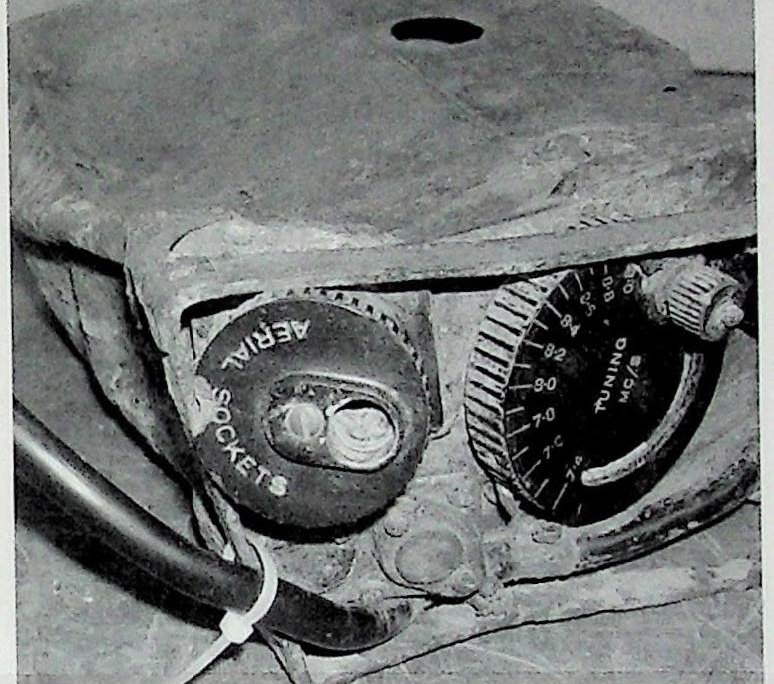 (photo Roland Bockhorst)
(photo Roland Bockhorst)
Radio receiver WS 38 Set Mk. II
Last year a WS 38 Set Mk. Il radio receiver was unearthed during excavation work near the village of Driel. Despite being covered in dirt and rust the set was still easily recognisable when it was handed in at the Airborne Museum. At first sight it seemed fairly complete, but some loose components were missing. The condition of the receiver was remarkably good considering it had spent almost sixty years under the ground.
After it had dried out, the soil was removed and the set was inspected. In order to avoid further damage it was cleaned very carefully, inch by inch, with a small brush, eventually revealing the original green colour. The knobs were easily cleaned with water after which the text on the knobs was visible. We were able to loosen the small setscrews and gently ease off the knobs, which allowed us to grease the small knob spindles so that they were again moveable. We were unable to treat the inside of the set because the housing was dented in such a way that the internals could not be removed. However, we were able to treat the inner surfaces with a special spray that will arrest further deterioration.
This equipment must have been used by the Poles who fought at Driel, either during or immediately after the Battle of Arnhem. With this MK. II set the lead for the throat microphone and the headset was mounted on the edge of the carrying unit. This type of connection was the cause of many cable breakages. Later types were modified, the cable being fitted directly to the set, which reduced cable failures. Actually, this type of radio transmitter/receiver was already out of date by the time the Battle of Arnhem took place. By then most WS 38 sets MK. II had been replaced by an improved type.
The WS 38 set was designed for short distance communication between infantry units as well as between infantry and tank crews. The set was waterproof and consisted of the set itself in a carrying unit, aerials, batteries in a bag, a headset and a throat microphone. The complete unit was carried and operated by one person.
Technical specifications:
System : AM R/T
Frequency : 7.3 – 9 Mhz
Range : 800 metres- 3200 metres
Batteries : HT/LT 150/3V
Weight : MK. Il set in carrying unit: 7 lb (just under 3,5 kilo).
The restored set is on temporary display in the acquisition cabinet in the Airborne Museum’s large room.
(Roland Boekhorst, maintenance staff)
‘News from Niall’
Niall Cherry, our representative in Britain, has drawn our attention to the following.
In the book ‘Remember Arnhem’ by John Fairley, the chapter on Wednesday 20 September 1944 reveals that one of Major Freddie Gough’s last actions at the Rhine bridge in Arnhem was the organisation of a message to be taken to divisional headquarters at the Hartenstein Hotel in Oosterbeek. Corporal Saul of the 2nd Battalion succeeded in reaching Oosterbeek on foot and delivering the message. Not much is known about this, but it seems strange that a courier should be sent at about the same time that the men at the bridge had established radio contact with Major General Urquhart. Bob Peatling, author of the book ‘Without Tradition, 2 Para 1941-1945’, delved further into this case and found the details.
Niall would like to know more about this occurrence, and anyone who may be able to help is kindly asked to get in touch with Niall Cherry, e-mail: niall.cherry@baesystems.com.
War graves website
Most people who are interested in the Battle of Arnhem and who have access to the Internet, know
set up in 1995 by Andries Hoekstra from Arnhem, and it has now become one of the major digital sources of information about operation Market Garden. Over the years the site has been visited more than a million times, and Andries has received more than 20,000(1) reactions over the same period.
The latest project being worked on by Andries and his colleague Frans Ammerlaan is a website containing the details of all British and Polish servicemen who were killed at Arnhem.
It is the intention that the site will show a photograph of the headstone of each of the dead and, if available, a portrait photo. Andries and Frans believe that by doing this the dead will be given ‘a face’, and therefore be less anonymous. In addition to this, as much information as possible will be included on each person. Frans Ammerlaan has already photographed many of the headstones in the Airborne Cemetery with a digital camera. AU the photographs will need editing before they can be put on the website.
There will be more information on this subject in the next Newsletter.
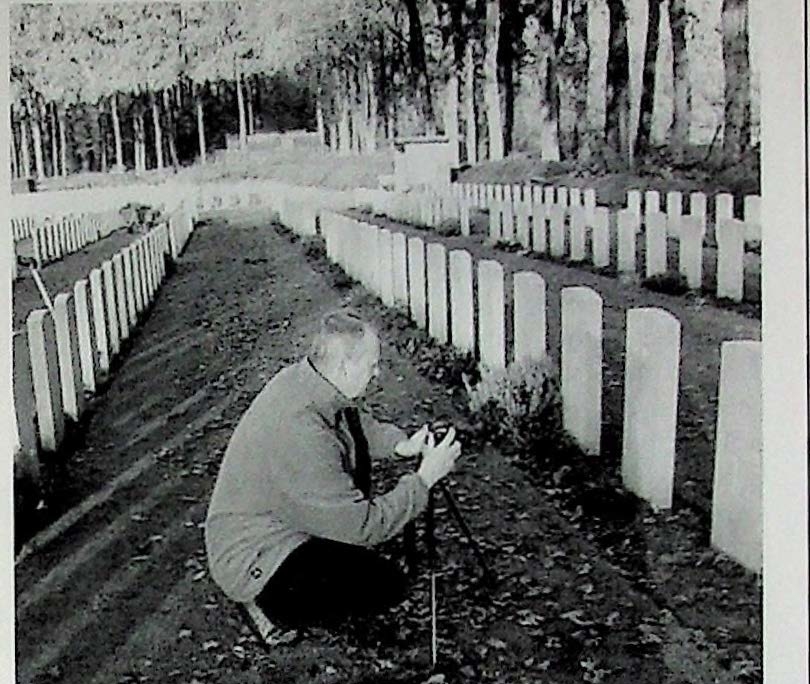
Frans Ammerlaan busy photographing all the headstones in the Airborne Cemetery in Oosterbeek for the new website on British and Polish servicemen who lost their lives.
(photo via Frans Ammerlaan)
Obituary: Paul Vroemen
We have been informed that Society member Paul Vroemen passed away on 13 November 2002.
Paul was a well-known ‘Arnhem historian’. As a boy he experienced the Battle of Arnhem at close hand, and the events made a deep impression on him. After the war he began collecting books, documents and photographs on the subject. A large part of the personal diaries he collected, was published in the book he wrote in conjunction with journalist C A. Dekkers, called ‘De Zwarte Herfst’ (De Cooise Uitgeverij, Weesp, 1984).
At Paul s request his comprehensive and interesting documentation and photo collection were placed at the disposal of the Gemeentearchief Renkum. This archive is now part of the Gelders Archief in Arnhem. The Paul Vroemen Collection is available for consultation at the address Markt 1.
Philip Reinders shows a German helmet that he found in 2002. The discovery was made during the excavation of a German anti-aircraft artillery site in the Rosandepolder at Oosterbeek.
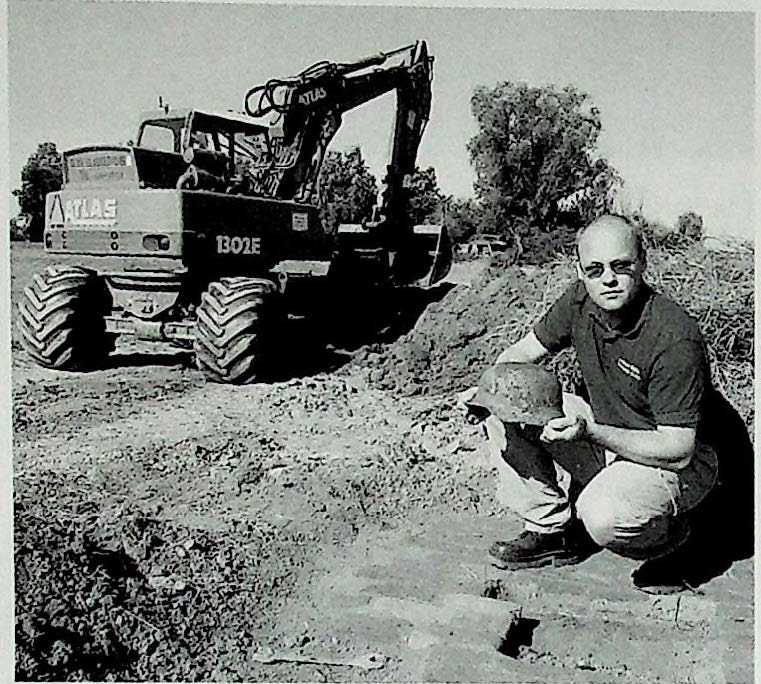 (photo Berry de Reus)
(photo Berry de Reus)
WW2 and the Rosandepolder
A few months ago the Rosandepolder in Oosterbeek, the flood plain between the river Rhine and Benedendorpsweg, revealed a number of remarkable finds that provide a glimpse into events from the 1940-1945 period.
During the removal by the water company Waterschap Vallei & Eem of a small dike close to the river, the remains of a German anti-aircraft artillery site were uncovered.
Actually, it concerns two Flak positions, both of which are easily recognisable in allied aerial photos taken before 17 September 1944.
At one site the finds included a small paved area, probably made using street paving bricks from the nearby brick factory (incidentally, no longer operational). The water company has left the foundations in place as a sort of small monument.
Shortly after the above-mentioned finds were made, the wreckage of a German fighter aircraft was unearthed during other regular excavation work. This site is relatively close to the houses on the south side of Benedendorpsweg. At first it was thought to be the wreck of a Focke Wulf FW 190, it being known that such an aircraft did crash in the polder, but it turned out to be the remains of a Messerschmitt Me 109. Items found included parts of the cockpit, the propeller and the tail wheel. Eventually, thanks to the excellent co-operation between the Airborne Museum ‘Hartenstein’ and the Museum Vliegbasis Deelen, the objects were taken to Hoenderloseweg 10 at the ‘Kop van Deelen’ in Arnhem, the home of the latter museum.
Some historical facts are indeed known about both the above-mentioned subjects, but many details have yet to be discovered. Anyone who thinks he/she may have some information on the Flak sites and the crashed German fighter in the Rosandepolder, is kindly requested to contact Philip Reinders, Margrietstraat 4, 6991 XH Rheden; tel. 026 4954563 (ditto fax) or email abrg.reinders@12move.nl (Geert Maassen)
New study group
We have received the following message from our member Frank van Lunteren.
‘On 22 August 2001, Fred Baldino, James McNamara and I established the “American Dutch Airborne Research Group” (ADARG). The chairman is James McNamara, and Fred Baldino is vice-chairman. Fred served as a corporal in A Company, 504th Parachute Infantry Regiment. Both the chairman and vice- chairman live in the United States.
The aim of this still-infant group is to research the histories of the 82nd and 101st American Airborne Divisions, the 1st British Airborne Division, and tire 1st Polish Independent Parachute Brigade.
The group has 11 members, seven in the US and four in the Netherlands.
Anyone wishing to know more about this study group should contact Frank van Lunteren, macfrank82@hotmail.com (email).
‘De Slag om de Ginkelse Heide’ (The Battle for Ginkel Heath)
A book with the above title has recently been published. Its author is historian Carel Verhoef, who lives in Ede.
The battle fought by the British and Polish Airborne at the Arnhem road bridge and in the Oosterbeek perimeter is well-enough known. Far less well- known is what happened during the first few days of Operation Market Garden at Ginkel Heath, just east of Ede. The men of the 4th Parachute Brigade under the command of Brigadier John Hackett landed there on 18 September 1944. This drop lasted little more than nine minutes all told, and was just part of the military activity that took place on and around this Ede heathland.
7th Battalion The King’s Own Scottish Borderers, which landed a day earlier at Renkum and had the job of protecting the dropping zone at Ede, had already reached the heath by the afternoon of 17 September, and became involved with a number of German units and a battalion of Dutch SS in the early evening.
hr most books about Operation Market Garden this episode rarely rates more than a paragraph. Using official Allied, German and Dutch documentation, accounts from participants, literature and situation sketches, Verhoef’s book paints a detailed picture of the contribution made to the Battle of Arnhem by the 7th Battalion The King’s Own Scottish Borderers and 4th Parachute Brigade, before their involvement in the fighting in Arnhem and Oosterbeek. There is also a brief summary of the background to the battle.
The book is based on the similarly named article published in 2001 in the 3rd ‘Bulletin van de Tweede Wereldoorlog’ (Bulletin from the Second World War). The subject is further explored with the aid of the most recent literature, documentation and personal reports.
In his acknowledgements the author is full of praise for the help he received from Dr A. Groeneweg OBE and other Airborne Museum staff, including Mr R.N. Sigmond, whose personal archive was very gratefully consulted by the author.
‘De Slag om de Ginkelse Heide, 17 en 18 September 1944’ by C.E.H.J. Verhoef, was published in 2002 by Uitgeverij Aspekt in Socstcrbcrg. The book comprises 124 pages, is illustrated with photos and maps, and costs € 12,98.
Appeal
Member John Sliz has sent us the following appeal.
‘I am currently engaged in a research project into the role of the 20th and 23rd Royal Canadian Engineers during operation ‘Berlin’. This was the operation that took place on the night of 25/26 September 1944 in which the remnants of the 1st British Airborne Division were withdrawn from the ‘Perimeter’ in Oosterbeek, and ferried back across the Rhine.
I would like to get in contact with veterans from these engineer units as well as with veterans of the 1st British Airborne Division who took part in this withdrawal. I want to put their stories down on paper. I am also looking for reports and accounts about this operation. I intend publishing the result of this research.’
John Sliz’s address is: 24 Brauburn Avenue, Etobicoke, MGP 273, Ontario, Canada: email thesliz@hotmail.com.
Theme Day: Museum Vliegbasis Deelen
Member Philip Reinders has sent us the following message about his private initiative: T wish to organise a theme day for members of the Friends’ Society in the museum at Deelen on 14 June next. In connection with this I would like to make an appeal to Friends who undertake research into certain aspects of the Battle of Arnhem. This could involve a specific British, Polish or German unit, or it could be into any other subject relating to this military operation.
I have already approached a number of people, and they have promised their support. Of course it would be much nicer if even more people would be prepared to join in. It is a great opportunity to meet others with the same interests, and to let them see what sort of research you’re involved in, and, who knows, perhaps you would be able to exchange information with other researchers. For the non¬researchers among us it is a chance to see what these people do, to talk to one another about it, and maybe answer each other’s questions.
The theme afternoon will cost € 4 for members of the Society of Friends of the Airborne Museum on presentation of their membership card. This charge includes admission to the museum, a guided tour, and coffee and cake. Among the items to be seen in the Deelen museum is a large exhibition about the gliders used at Arnhem.
Those interested can book with Philip Reinders, Margrietstraat 4, 6991 XH, Rheden, or on the Arnhem Battle Research Group website, http://www.arnhembattle.com.’
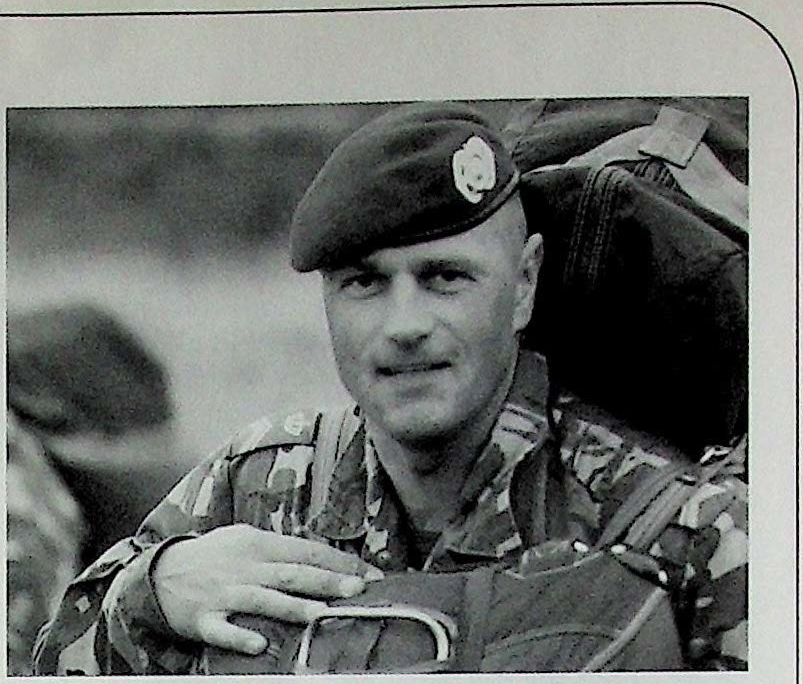 On Saturday 21 September last year, the honour -as a soldier serving with the Air Mobile Brigade – of taking part in the parachute drop at Ginkel Heath fell to our member Peter Steenhuis.
On Saturday 21 September last year, the honour -as a soldier serving with the Air Mobile Brigade – of taking part in the parachute drop at Ginkel Heath fell to our member Peter Steenhuis.
The photograph was taken prior to departure from Soesterberg airbase.
(photo via Peter Steenhuis)

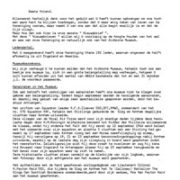
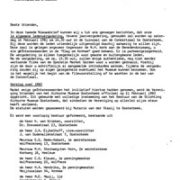
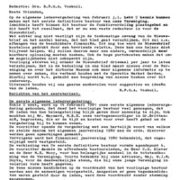
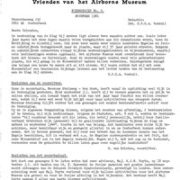
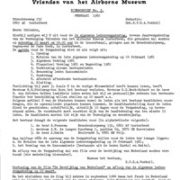
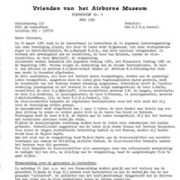
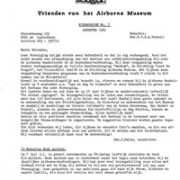
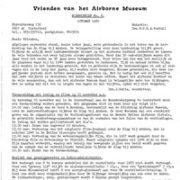
Plaats een Reactie
Vraag of reactie?Laat hier uw reactie achter.